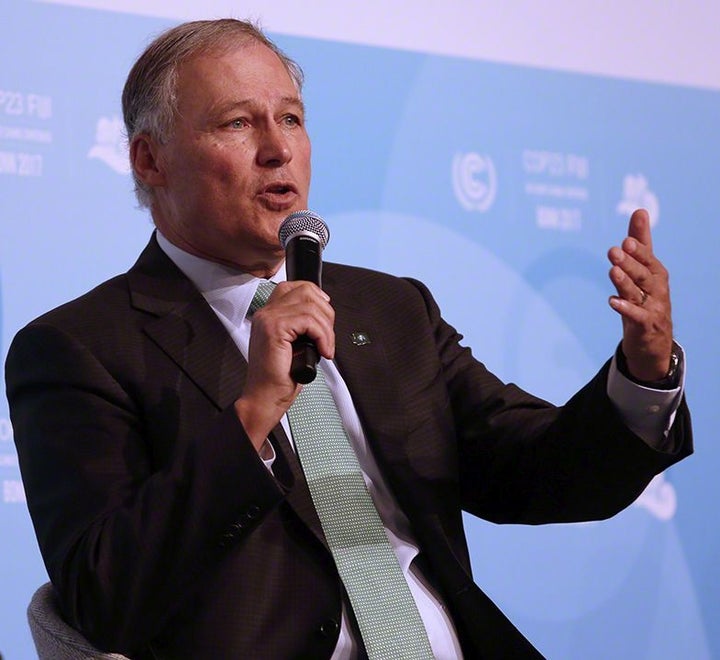
Gov. Jay Inslee discussing the U.S. Climate Alliance during the United Nation's Climate Change Conference's 23rd Conference of the Parties (COP23) in Bonn, Germany on November 13, 2017. The alliance now consists of 14 states and Puerto Rico.
When still a congressman in 2008, Washington’s current governor, Jay Inslee, co-authored a book called Apollo’s Fire: Igniting America’s Clean Energy Economy and earned a reputation in Congress as a leading advocate of renewable energy.
Since his election as governor in 2012 and reelection in 2016, Inslee has tried to make Washington state a proving ground for the clean energy vision he first espoused in his book, but support in the state legislature has fallen short.
Although Democrats have been in control of the state House of Representatives since 2002, until recently, the governor’s efforts to pass clean energy legislation have at times been thwarted by a Republican-controlled State Senate.
It refused in 2015 to consider a moderate cap-and-trade bill Inslee supported, and a state carbon tax long favored by the governor would also have been dead on arrival.
In what could be a turning point for Washington’s clean energy future, however, voters on Nov. 7 gave control of the Senate to the Democrats in a special district election. The coming months will now reveal whether the governor will be able to fully implement his ambitious climate protection, clean energy and job-creation agenda.
The governor has already made clear where he stands on these issues and the extent to which his policies diverge from the Trump Administration’s. Governor Inslee has referred to climate change—which the president has famously called “a hoax”—as a “slow-motion disaster movie.”
Governor Inslee is eager to implement bold, ambitious measures to reduce greenhouse gas emissions in Washington state. In 2014, he signed a broad executive order, the “Washington Carbon Pollution Reduction and Clean Energy Action,” to reduce the state’s greenhouse gas emissions while increasing its energy independence and economic competitiveness.
During his administration, the governor has been a strong proponent of clean energy technology, including the use of electric vehicles and the development of clean power storage devices, and biofuels, as well as electric ferries and electric ultra-high-speed rail.
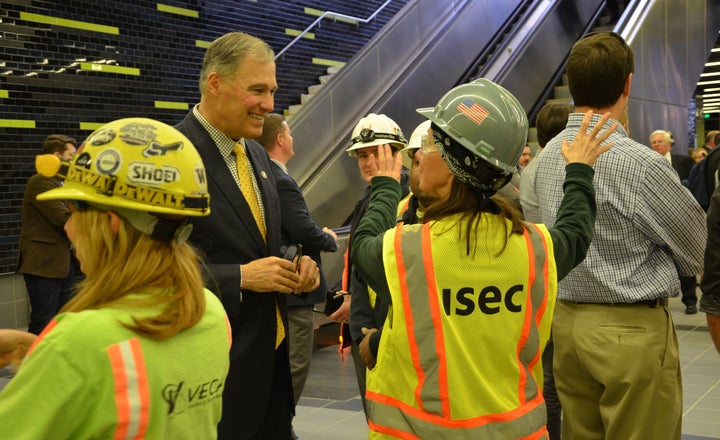
Gov. Inslee visiting a new Sound Transit light rail station at the University of Washington on April 17, 2015.
Governor Inslee was a co-founder in 2015 with New York Governor Andrew Cuomo and California Governor Jerry Brown of the U.S. Climate Alliance. The bipartisan alliance of states is committed to fulfilling the terms of the 2015 Paris climate agreement.
The 15 member states in the alliance account for 40 percent of the nation’s economic output. “We’d be the third largest economy in the world, if we were a nation,” Inslee said.
While the president champions coal, Governor Inslee in November joined a newly established international coalition known as the Powering Past Coal Alliance that aims to phase out coal power and ban new coal power plants unless they can capture their carbon emissions.
Inslee is also allied with the governors of California, Oregon, and the premier of British Columbia and various cities in the Pacific Coast Collaborative, representing 55 million people with a $3 trillion economy. The regional partnership is committed to accelerating the arrival of a low-carbon future with thriving, sustainable communities.
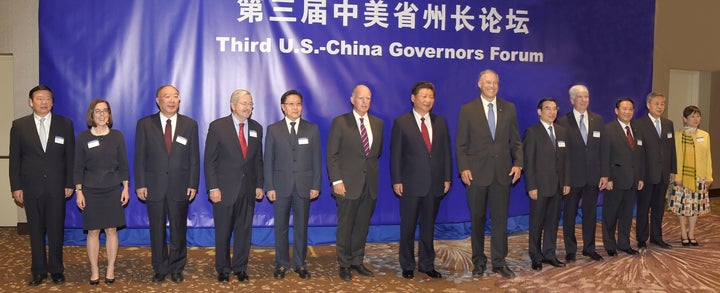
Gov. Inslee and a bipartisan group of U.S. governors met and signed an accord with Chinese governors on September 22, 2015 to promote clean energy technology and economic development.
Governor Inslee sees the West Coast as a blueprint. “This is how you build a thriving, innovative economy that combats climate change and embraces a zero-emission future,” Inslee said in a Nov. 13 statement from his office. “We know it’s possible because we’re doing it.”
Inslee is also a founding member of the Under2 Coalition. Members are committed to keeping global temperature from rising over 2℃ by reducing their carbon emissions 80 to 95 percent below their 1990 levels by 2050, or by limiting per capita annual greenhouse gas emissions to two tonnes a year.
Whereas Governor Inslee regards climate change as a global emergency, he sees it simultaneously as a tremendous economic opportunity. According to the Governor (see Q&A, below), the State of Washington is explicitly destined to lead the world in clean energy.
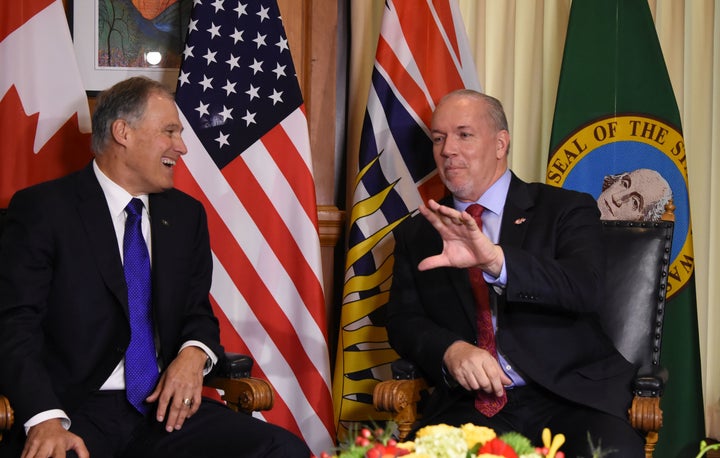
Gov. Jay Inslee meeting with British Columbia Premier John Horgan in Victoria, B.C., Nov. 21, 2017. They resolved to fight climate change, forge stronger regional transportation links, and create clean jobs.
As noted, however, Governor Inslee has found that his most ambitious clean energy plans were blocked by the state’s Republican-controlled Senate. With it now in Democratic hands, the governor is at last in a position to rapidly advance his clean energy agenda. If he is successful, an incidental result might be greater national prominence.
I spoke at length with Governor Inslee recently at his office in Seattle to discuss his aspirations for the State of Washington and his views on what states and other subnational governments can do to accelerate the arrival of a clean energy economy without the federal government’s support. An edited version of that conversation follows. It was held prior to the special election that gave Democrats control of the state legislature.
Q&A With Governor Jay Inslee
John J Berger: Your book Apollo’s Fire was about turning an economic crisis, a climate crisis, and a loss of manufacturing jobs into a clean energy economy. [But] that hasn’t happened, yet. I’d like to hear your thoughts about what the role of Washington state and other states can be in making the clean energy economy happen?
Ecology and Innovation
JI: I think this environmental emergency and simultaneous economic opportunity are perfect for the state of Washington to lead the world in. Because we have a very unique combination of [environmental] beauty and richness and diversity. Hardly any other place is more committed to the continuation of this richness for our grandkids and at the same time has an economic tradition of technological innovation. [We are] richly productive on multiple types of technological innovation. Starting with the first successful commercial jet airline, Boeing 707 to software at Microsoft, to right now, within a mile of this building, we are literally going to cure some kinds of cancer.
[Washington has] a really unique twinning of an environmental value, a commitment to our grandchildren, with a very productive way of seizing economic opportunity through technology. It’s kind of the destiny of our state to lead the world. So I am excited about what we are doing here.
JB: Could we talk a little bit more about what your plans and aspirations are for making the state a proving ground for some of the ideas espoused in Apollo’s Fire?
Capping Carbon Pollution
JI: There are two aspects. One, we want to reduce our carbon emissions. We’re doing some very effective work on that by my executive order to reduce carbon pollution. [It is] the first cap on carbon pollution by individual polluters [ever] created by executive decision. That’s going to prove effective. It requires reduction at a certain rate of all of the major polluters, and so, it covers almost two thirds of our economy. That’s just very effective, being responsible for our own emissions. We got a great incentive program for buying solar panels and electric cars. We got a great research effort at University of Washington and Washington State University.
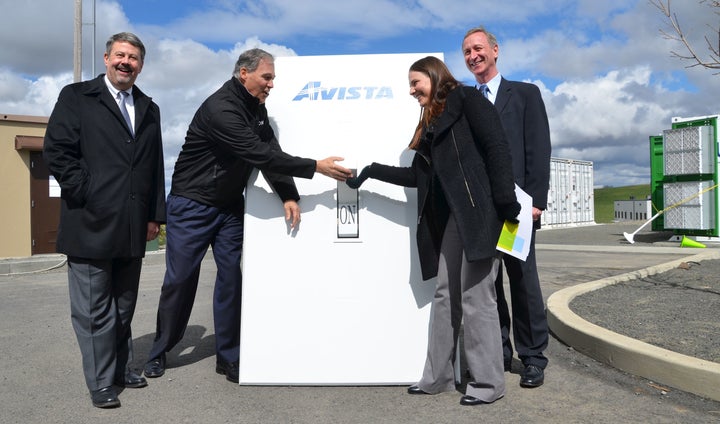
Flipping the switch on a battery created by a partnership between Avista Utilities, Pacific Northwest National Laboratory and UniEnergy Technologies, April 2, 2015.
Clean Energy Development Support
JI: So we’ve got the first order of business: being responsible for our own carbon. But the second is the grander scheme, which is that we will show the way to technologies for the rest of the world. And to create those technologies. Our goal is to be the springboard for multiple technologies we can share with the world and hopefully sell to the world, to the extent we can make it here. That’s another part of what I consider our destiny. We are fulfilling it and our policies are designed to do that.
My Clean Energy Development Fund is working to help spin off businesses. The one I like to point to, the University of Washington, came up with some research in vanadium chemistry. Then we started a Clean Energy Fund that helps businesses develop.
JB: Does the vanadium research lead toward a new battery?
JI: Yes. Now they’re making the world’s largest vanadium flow battery for grid-scale battery storage in Mukilteo, Washington, and they are selling it all around the world! It’s a real company making a real product that can allow the integration of renewable energy into the grid. So that destiny is being fulfilled.
We’ve got the largest manufacturer of carbon-fiber substrate that goes into electric cars. It’s a company called SGL in Moses Lake. The largest manufacturer of silicon substrate for silicon solar panels is in Moses Lake, Washington. Driving up here, I just saw a big semi-truck with these giant tanks of [silane] for use in making those silicon for solar cells. So we are seeing a fulfillment of that vision—both being responsible for our own carbon and giving the world technologies to help. It’s exciting.
JB: Could I ask you for some idea of the scale of things that are happening here? For example, you mentioned the carbon cap. How much carbon does that actually reduce? You mentioned the Clean Energy Fund; how many dollars are we talking about? And then also in terms of the impact . . . .
Avoided Emissions
JI: One hundred seventy million metric tons of CO2 will be avoided by 2035 because of the cap that I put on. . . I think it’s a percent and a half reduction every year for major polluters. And that sounds small, but over time, that gives you significant savings.
JB: It ratchets [carbon emissions] down.
JI: It ratchets down. And it’s not a rate, it is an actual quantity. So, we are not rating it down a percent and a half, but it’s an actual emissions cap.
JB: Yes, because if you did cut emissions a percent and a half a year, the reduction would get steadily smaller and smaller.
JI: Yes. It is a cemented, concreted, legally enforceable cap. It is being challenged by the fossil fuel industry, but we have every confidence that it will withstand the challenge. And it’s pursuant to our state Clean Air Law, so the President cannot stop us. He can be the most twitterific climate denier in world history, but he cannot stop us from enforcing our own laws, and that’s what we are doing here.
JB: So, that is the Carbon Pollution Reduction and Clean Energy Action? I’m not too familiar.
Technical advisor: Yep.
Electric Vehicles
JB: In terms of the Zero-Emission Vehicle Program, how is that going, and were you able to get across your EV Infrastructure Bank and your EV tax incentives?
JI: It’s very successful thanks to our incentives, including our sales tax exemption on mid-range electric vehicles. Our EV adoption rate increases 21% every year on average and we now have some of the highest per capita EV market share in the country.
JB: In the state fleet or in the whole state?
JI: In the whole state. But we do have, I believe, one of the largest state EV fleets. My EV Fleets Initiative requires that 20% of all new passenger vehicles in the state are electric by the end of this year, and we’re beating that goal. We just bought our first hundred [Chevrolet] Bolts for our state vehicle fleet.
The other part that’s been successful is our charging station infrastructure. Through our EV Infrastructure Bank and the West Coast Electric Highway, we are building high speed charging stations in strategic locations across the state to reduce range anxiety. In addition, we’ve changed our building codes to make charging at home and work more practical. We were one of the first states to receive support from the two billion dollar Volkswagen ZEV Investment Fund, and that will help us build more high-speed charging stations. We’re planning to use Washington state’s $113 million Volkswagen Mitigation funds to do even more electric charging stations, electric buses, and electric ferries.
The technologies are coming on faster than many people think. Look at what GM said they’re going to do. And Volvo said we’re not building anything but electric [or hybrid] cars after [2020]. But the technology is just faster than a lot of people thought. I’ve always been bullish on electric cars.
The distance that [EVs] have come since I’ve written this book—I don’t know if you remember this—but one of the little stories that I talked about [in Apollo’s Fire] was the Cal Car guys. Which are these guys in the computer industry in California.
JB: Yes, they started in a garage.
An Industrial Transformation
JI: In a garage, and they literally were frustrated because Detroit wouldn’t make electric cars. They said, well, were gonna show ’em how it’s done. They went out and took a Prius and made it an electric car. Since then, which is what, ten years, we now have major manufacturers competing for bragging rights on who is going to be the most ambitious on electric cars. This is an incredible industrial transformation in the blink of an eye. I think it is a cause for optimism here, how fast things can go.
JB: Yes. I can feel very optimistic when I look at the electricity sector, and the opportunity for providing even 100% renewable power. Some municipalities are going for it, and [working on] other sectors. But when I think about all uses of energy—electricity is maybe a fifth nationally. Has your administration in any way addressed those sectors of the economy that can’t readily be electrified?
JI: Our [carbon] cap affects the transportation sector as well. It drives electrification other than [of] the transportation fleet because it affects refinery production. So we have, arguably, a cap that applies not only to manufacturing, but also to the transportation industry, because it affects the refinery operations.
Aviation Biofuels and Hybrid Airplanes
JI: Your question is, what have we done to affect [the energy demands] that are most difficult [to decarbonize]? The most obvious one is aviation fuels. This is one of the most challenging technologies, and we have a very active effort between Pacific Northwest Labs, Alaska Airlines, Boeing, and Washington State University for the development of biofuels, and it’s had some success. We’ve now had the first flights on biofuels— transatlantic flights.
JB: Are you working [with and on] the second generation of biofuels?
JI: Yes, yes. And, you know, I can’t say it’s commercially viable at the moment, but I think there’s some promise there. We actually also have a company here [Zunum Aero] that is trying to make an electric airplane. And they’re serious. They want to [be able to flight test a prototype within two years]. They’re actually quite ambitious. They want to make a nine-seat sort-of commuter airplane. And Boeing just invested some money in them. So the sky’s the limit! So yes, we’re trying to help the aviation industry with what otherwise would be a tough transition.
JB: That is phenomenal news. I hadn’t understood that there was a possibility for a nine-seat commercial electric airplane.
JI: As I understand the way it works is you have an auxiliary take-off. So, you actually have an internal combustion to help you take-off, and then use electricity.
Regional Actions by States
JB: Going back to what states can do, what potential do you see for regional action by states working in concert to achieve clean energy goals?
JI: Well, I think that there’s a lot we can do. One is we can be vocal— as we have been— to tell the rest of the world community what continues to work. We have this Unites States Climate Alliance, which [California Governor] Jerry Brown and I and [New York Governor] Andrew Cuomo stood up. We did it within 36 hours of Trump pulling out of Paris, and that’s an effective thing.
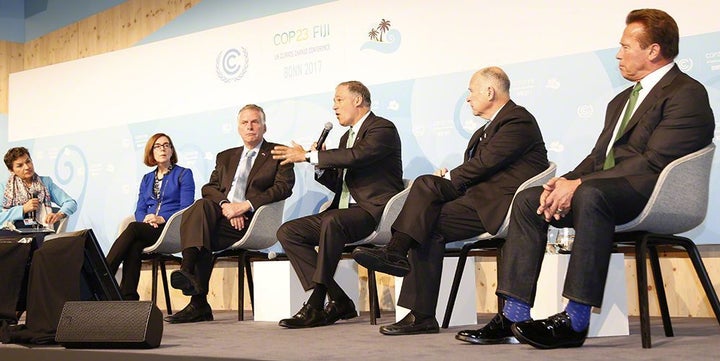
Gov. Jay Inslee speaking during a panel discussion about the U.S. Climate Alliance during the United Nation's Climate Change Conference's 23rd Conference of the Parties (COP23) in Bonn, Germany. He was joined on the panel by Oregon Gov. Kate Brown, California Gov. Jerry Brown, Virginia Gov. Terry McAuliffe and former California Gov. Arnold Schwarzenegger to reassure global leaders of American leadership on climate change. At left is moderator Christiana Figueres, Executive Secretary of the UN Framework Convention on Climate Change.
I think it’s important to tell the rest of the world we’re moving. This is not a small thing. This is 40 percent of the U.S. economy represented by these 15 states. This is a big deal. We’d be the third largest economy in the world if we were a nation. . . . . That’s a significant statement. Making a statement to the world to keep world confidence up is important in and of itself.
Beyond that, [we need] to look at some of our grid modernization and efficiencies through the grid to find out how we can [coordinate] our domestic policies to allow renewable energy to reach its maximum usage. And that requires some grid discussions.
Common Carbon Markets
JI: The question is, can we merge markets for carbon pricing? That remains a possibility. California is joining Quebec and Ontario.
JB: Was that the Regional Greenhouse Gas Initiative, RGGI?
JI: Yes, yes. And that really is a possibility for us. We’re looking at a carbon pricing system as our next step. Hopefully in the next session of the legislature.
JB: Would that be a carbon fee?
JI: Whether it’s a carbon fee or a cap-and-invest, or whether it’s a straight carbon tax, that remains under discussion. But if our state did adopt a cap-and-invest or cap-and-trade system, we might be able to have a common market with California and potentially, Quebec and Ontario. So that is a possibility. I can’t tell you right now, sitting here, what direction we’re going to go. I can’t tell you we’re going to achieve it in the next session of the legislature. We’ve got a special election in three weeks that may determine that. So, yes. So, there’s common markets.
We can share policy successes, which is important. We’re learning what worked from each other, you know? The Clean Fuel Standard in California I think has worked well. Unfortunately, my Republicans blocked me from using it here. But we can learn things from each other, and that’s important. We can certainly share research and we are always looking for a way to do that. So, we can have our research institutions collaborate.
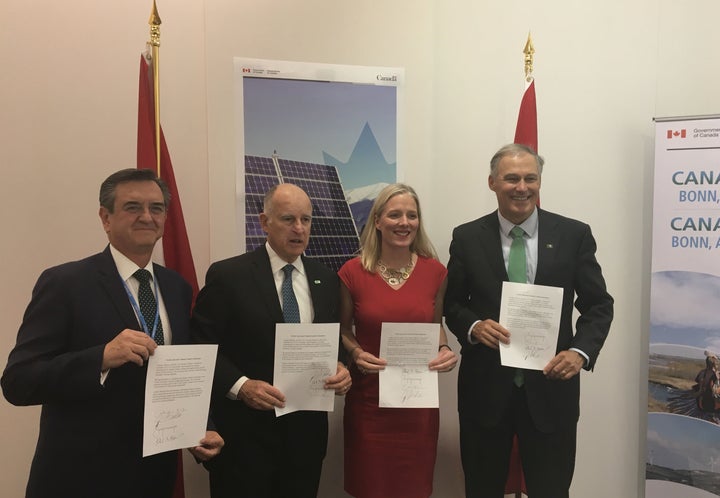
Gov. Jay Inslee (right) joins, from left, Mexico's Deputy of Environmental Policy Rodolfo Lacy, California Gov. Jerry Brown, and Canada's Minister of Environment and Climate Change Catherine McKenna to create the North American Climate Leadership Dialogue while at the United Nations Climate Change Conference's 23rd Conference of the Parties (COP23) in Bonn, Germany last November. The partnership is composed of U.S. Climate Alliance states, Mexico, and Canada, with the goals of fighting climate change and supporting clean-energy growth across North America.
A Political Sea Change
JB: You said in Apollo’s Fire, a new political environment must be established for the success of the clean energy revolution to be assured. I was wondering what you really meant by that, and how we do it?
JI: I can’t remember what I meant by that, but it sounds like a good quote, so I’m standing by it. What I imagine I meant was several possibilities. I mean one was, we do need a change in politics in a variety of ways to make all this possible. Obviously having a climate denier in the White House does not help. Having a climate denier majority in the Senate and House does not help, but is not the end-all of this discussion, because I do believe we are seeing a political revolution and evolution.
I think we are approaching a tipping point where people’s desire and demands for action are overcoming willful ignorance of climate denial. That’s happening for two reasons right now. It’s happening because people are seeing this in their own lives. Two weeks ago, people woke up and their cars were covered in ash from the forest fires in Seattle. This has never happened before.
JB: Was this the fires nearby?
JI: Nearby. They’re 80 miles away. And we’ve never had ash on our cars in the morning ever in Washington history until this year, because the forest fires are devastating, a little bit like California. That’s a new thing! And people are saying, wait a minute, something’s happening here, and I’m witnessing this. So, what used to be a graph is now a reality. And that’s changing people’s perception of this problem.
Secondly, we just have so much huge technological innovation making these [clean energy] products accessible and cheap. Solar [costs have] come down by almost half every two or three years. Jobs are increasing in the solar industry at a rate 17 times faster than the average rate in every other industry in the United States. It’s the hottest ticket in town. So you’re having this combination. And what I have found is that politics can change like that. Just look at the marriage-equality issue. People thought it couldn’t happen 10 years ago, and then boom, we hit a tipping point.

Gov. Inslee delivering his State of the State speech on Jan. 13, 2015.
Hoping for Bipartisanship
JI: We’re going to have to have an epiphany by Republicans or they’re going to have to be replaced—one of the two, but either one is fine, in some sense. I have been very frustrated here that to date we have still not had Republican leadership on this, but I keep hoping it’s going to arrive. Next year, I hope that we will find some bipartisan carbon initiatives. I hope that’ll happen.
In California, there were nine republicans that voted for the cap-and-trade system. When I asked one of the leaders why he voted for it he said, “because my party will be extinct in the years to come if we don’t start to become a positive force dealing with climate change. We will become extinct.” All the young people get this—everybody under 40. You can’t find a climate denier under the age of 40. So he understood. Hopefully more will understand it and come to help us find a bipartisan solution to this. I think that’s what I probably meant.
Political and Educational Reform
JB: My final questions is a big picture one. Do you think that we can fix our climate problems without fixing our democracy and fixing our educational system?
JI: Well, I don’t know, but I’m trying to do both. On the educational system, actually in the last week, I’ve been trying to be very active to improve the science that our kids are getting on this subject to make it more uniform so that every child gets some education on the thermodynamics of how carbon works in the atmosphere. Allows ultraviolet light in, and doesn’t allow infrared light out. I want every child to just know that basic science. We’re trying to improve that in our public-school system.
JB: That’s great.
JI: On the question of whether the democratic system has to change, I think the jury’s out on that. It sure would help if we had less gerrymandering so climate deniers haven’t gerrymandered the entire U.S. House of Representatives. That could improve.
We could have a popular vote decision [in Presidential elections]. The Electoral College gave us a climate denier last year, not the vote of the people. That could improve. But maybe we can have progress anyway, that will be possible.
We have a special election here in a few weeks in the 45th Electoral District. We have a contest between two parties, and my candidate really understand climate change. We might succeed without changing the whole political system—just elect the right candidate!
[Note. On November 7th, in a costly and hotly contested election, voters in that 45th District (East King County) elected Democrat Manka Dhingra to the state senate despite oil company support for Republican candidate Jinyoung Lee Englund, giving Democrats control of the state legislature.]
________________
John J. Berger, PhD. (www.johnjberger.com) is an energy and environmental policy specialist who has produced ten books on climate, energy, and natural resource topics. He is the author of Climate Peril: The Intelligent Reader’s Guide to the Climate Crisis, and Climate Myths: The Campaign Against Climate Science, and is at work on a new book about climate solutions.
